|
Alco C-415 demonstrator on the McCloud River
|
||||||||||||||||||
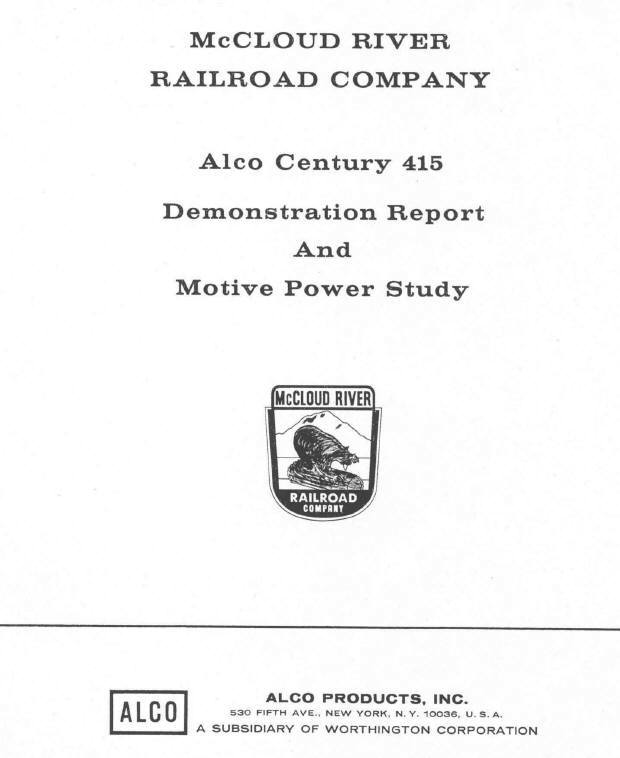 |
||||||||||||||||||
| Caption: The cover of the report generated by the American Locomotive Company detailing the performance of their C-415 demonstrator unit on the McCloud River Railroad. Courtesy of Tom Moungovan, from the Ray Piltz collection. | ||||||||||||||||||
|
|
||||||||||||||||||
|
Background The McCloud River Railroad had a long relationship with the Baldwin Locomotive Works. Seventeen of the twenty seven steam locomotives owned by the company were
The
The American Locomotive Company (Alco) provided the only real competition to Baldwin during the steam era, and like
Only six of the
|
||||||||||||||||||
|
|
||||||||||||||||||
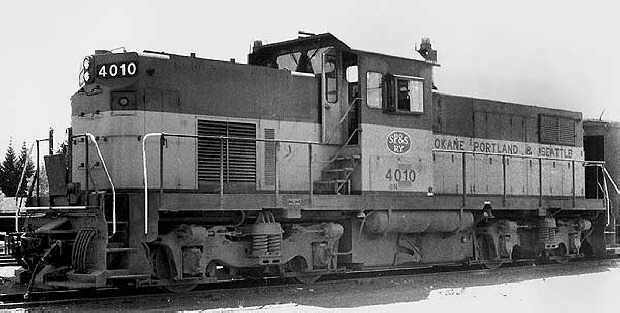 |
||||||||||||||||||
|
|
||||||||||||||||||
|
|
||||||||||||||||||
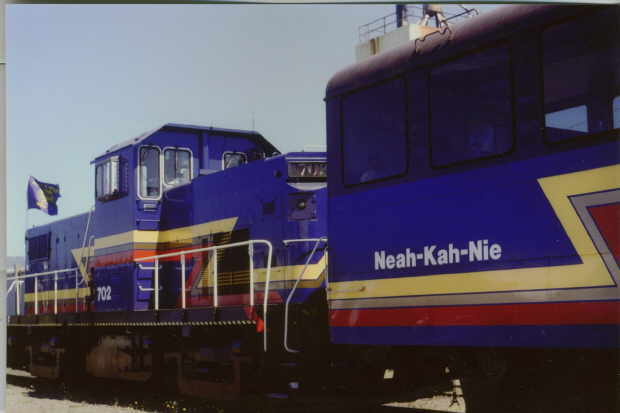 |
||||||||||||||||||
| Alco C-415 used by the Oregon Coastline Express on their tourist train out of Tillamook, OR on the Port of Tillamook Bay Railroad. This unit was built in 1968 for the Southern Pacific, and it passed through the hands of the Columbia & Cowlitz Railroad before arriving on the Oregon Coastline Express. After the OCE folded the unit went to the Spirit of Oregon Dinner Train, then to the Mount Hood Railroad, then to the Burlington Junction Railroad in
|
||||||||||||||||||
|
|
||||||||||||||||||
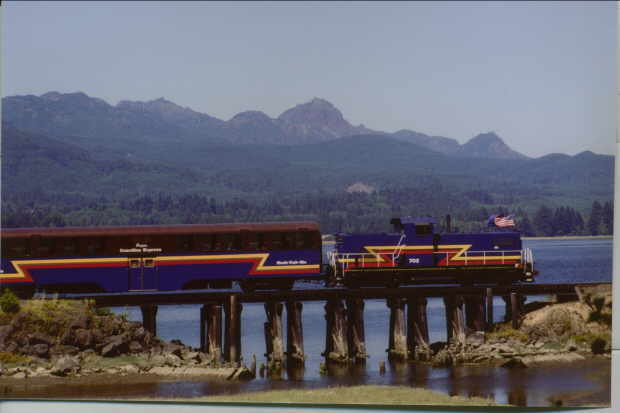 |
||||||||||||||||||
| Another view of the Oregon Coastline Express C-415 along the shores of
|
||||||||||||||||||
|
|
||||||||||||||||||
|
The C-415 was intended by Alco to be a medium duty road switcher, capable of handling most light low speed road jobs while being equally adept at yard switching chores. The model had the cab built in the middle of the unit, slightly off center to one side. The model was introduced in 1966 and was in production until 1968. Several different options were available, including three different cab heights and a choice between standard AAR-type switcher trucks or high adhesion trucks. The prime mover, main generator and equipment blowers were located in the longer of the two hoods. The prime mover was an 8-cylinder model 8-251E, which was very unreliable and very off balanced. A drive shaft from the front of the prime mover ran underneath the cab floor to the shorter of the two hoods, where it ran the air compressor and flan clutch mechanism. The off-centered location of the prime mover caused the unit to be badly off balance, leading to excessive wheel slip and wheel wear. The cooling system was also problematic, as coolant had to be transported from the prime mover at one end of the unit to the radiator at the other end of the unit. The model was hardly a success, as only 26 were built. The 26 consisted of 1 demonstrator unit (medium height cab, AAR-B trucks), 1 to Monongahela Connecting in Pittsburgh, PA (low cab, Hi-Ad trucks), 1 to Chehalis Western in Washington (High cab, Hi-Ad trucks), 1 to Columbia & Cowlitz in Washington (High cab, Hi-Ad trucks), 2 to Spokane, Portland & Seattle (Medium cab, Hi-Ad trucks), 10 to Rock Island (Medium cab, AAR-B trucks) and 10 to the Southern Pacific (High cab, AAR-B trucks). |
||||||||||||||||||
|
McCloud operations at the time At the time of the testing, the
1. McCloud to Burney with trips to the lumber mills at Pondosa, Lorenz and Scotts and return to McCloud. This operation requires two units between the hours of 8:00 AM and 8:00 PM. 2. McCloud to Lookout Junction and return to McCloud. This operation requires one unit between the hours of 8:00 PM and 3:30 AM. 3. McCloud to
4. One unit is required at the McCloud Yard as a switcher between the hours of 8:00 AM and 8:00 PM. |
||||||||||||||||||
| The Testing | ||||||||||||||||||
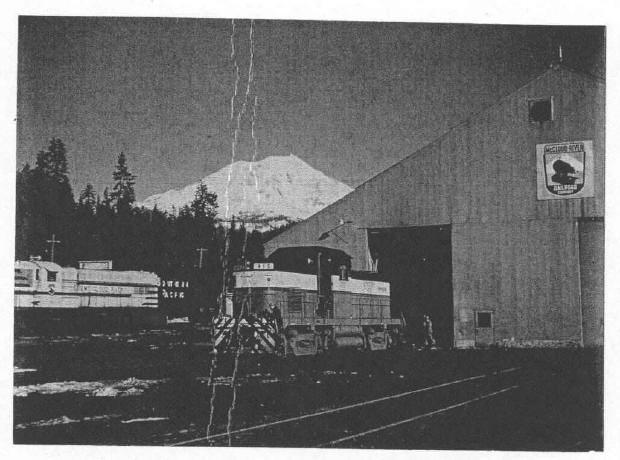 |
||||||||||||||||||
| Picture from the report of the Alco C-415 demonstrator sitting in front of the McCloud shop. Courtesy of Tom Moungovan, from the Ray Piltz collection. | ||||||||||||||||||
|
|
||||||||||||||||||
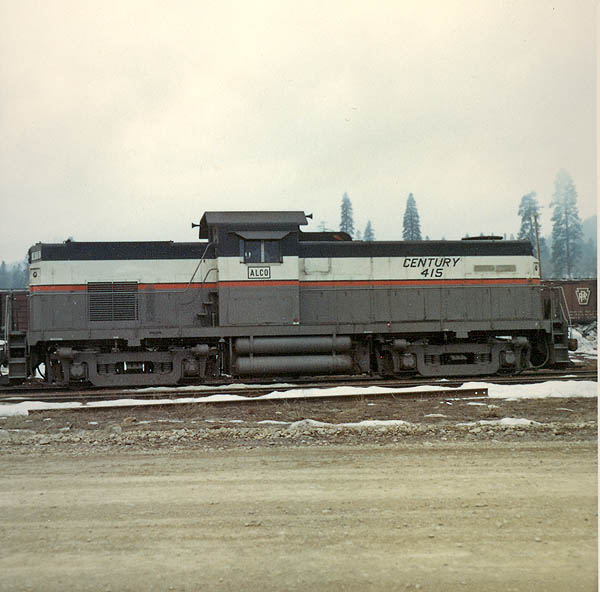 |
||||||||||||||||||
| A color shot of the C415 demonstrator in McCloud. Photograph from the Travis Berryman collection. | ||||||||||||||||||
|
|
||||||||||||||||||
|
The Alco report contained a day-by-day report of the movements of the unit, including analysis of the performance of the unit, some of which is worth reporting here. The descriptions also provide some fascinating insights into the operations of the road at the time. |
||||||||||||||||||
|
Monday, 6 February 1967
The demonstrator unit arrived at Lookout Junction via the Western Pacific and was towed dead to McCloud. The first solo run of the unit took place that night, when the unit took a train of 607 trailing tons (no caboose) to Signal Butte. The unit slipped quite a bit on the 4% grade leading up to the switchback, and at Signal Butte the demonstrator was cut off and returned to McCloud. Alco stated that the tonnage rating of the C-415 on a 4% grade is 560 tons at a continuous speed of 7.2 miles per hour, assuming an average car weight of 60 tons. Alco concluded that the demonstrator unit (which weighed 255,000 pounds) may have been too light to produce adequate adhesion to the rail. Tuesday, 7 February 1967 The demonstrator departed McCloud at 8:00 AM on the point of a
The return trip to McCloud saw the demonstrator hauling 976 trailing tons, consisting of 13 loads and one caboose. Three of the 13 loads were 110-ton woodchip loads. The C-415 stalled out on the 2.5% grade at MP 47, about one mile south of Cayton. Alco attributed the stalling out to a bent sander on the lead sander on the right side of the locomotive, which caused sand to be deflected away from the flange area. The demonstrator ended up doubling the hill to Cayton, where the train was re-assembled. No further problems were encountered, and the train arrived back in McCloud at 8:00 PM.
Immediately after arriving back in McCloud the C-415 took 7 cars (440 trailing tons) to Lookout Junction and returned with empties. Wednesday, 8 February 1967
The demonstrator made a successful roundtrip from McCloud to Burney and return on this day, switching lumber mills at Pondosa, Scotts and Lorenz along the way. The return trip departed from Burney at 3:35 PM with ten loads, three empties, and one caboose for a total trailing weight of 801 tons. Five additional loads weighing 289 tons were picked up at Obie, which filled out the train to 1090 tons. The unit made McCloud without any problems. After arriving at McCloud the unit once again went to Lookout with eight loads, one empty and one caboose for a total trailing weight of 548 tons. No problems were recorded. Thursday, 9 February 1967 On this day the demonstrator again went to Burney, taking one load and sixteen empties for a total trailing weight of 530 tons. No problems were encountered. The returning train from Burney consisted of eleven loads, one empty and one caboose for a total trailing weight of 828 tons. Some slipping was reported, but the unit did not stall out. Upon arrival back in McCloud the C-415 was put to work switching the yard for the next four hours. Once the switching chores were complete the unit along with two Baldwin diesels (not otherwise identified) took 17 loads up the hill towards
Friday, 10 February 1967 The C-415 was again dispatched at 8:45 AM from McCloud, heading to Burney with three empties and a caboose. On the return trip the unit pulled twelve loads and a caboose for a total trailing weight of 907 trailing tons, including three chip loads with a cumulative weight of 290 tons. The unit made it to Obie with only an occasional slip. Five additional loads weighing 297 tons were picked up at Obie, increasing the train weight to 1204 tons. The C-415 made it back to McCloud with that train. The unit was again dispatched for Lookout Junction at 8:00 PM with fourteen loads and one caboose for a total trailing tonnage of 879 tons. The unit was apparently interchanged back to either the Great Northern or Western Pacific upon arrival at Lookout Junction. Conclusions
Alco developed tonnage ratings for it’s C415 model based on the data collected during the trials. The tonnage ratings were as follows:
The above table was based on an average car weight of 60 tons and are rated for a C415 operating at a continuous speed of 7.2 miles per hour with a 72/14 gear ratio. In the table above, Westbound trains would be those traveling from Burney to McCloud, or from McCloud to
Epilogue
American Locomotive Company submitted a proposal as part of the report that the McCloud River Railroad replace all six active
| ||||||||||||||||||
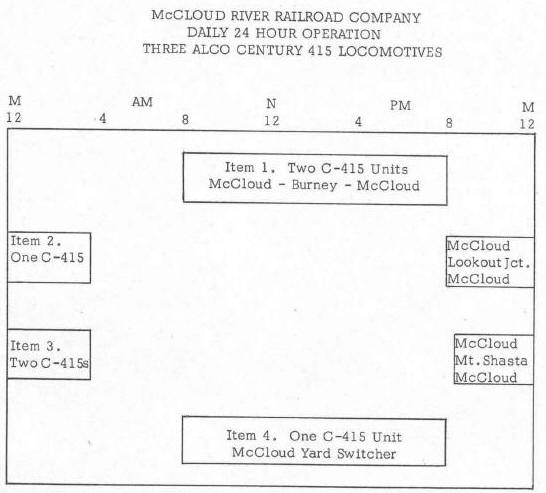 |
||||||||||||||||||
| Graphic depicting how the McCloud could maintain 24-hour a day operations with three C-415s. Courtesy of Tom Moungovan, from the Ray Piltz collection. | ||||||||||||||||||
|
|
||||||||||||||||||
|
In hindsight, it is fortunate that the
The demonstrator unit that tested on the McCloud was sold to an Australian mining firm and is currently on display at
Below are several pictures of a C415 that closely resembles what McCloud River C415s might have looked like, with the high profile cab and the high adhesion trucks. This particular unit was built in July 1968 and c/n 6003-1. It served a succession of logging and lumber railroads owned by Weyerhaeuser Timber Company (Chehalis Western, Curtis Milburn & Eastern, back to Chehalis Western) in the greater
All photos are by Tyler Whitcomb and are used with permission. |
||||||||||||||||||
|
|
||||||||||||||||||
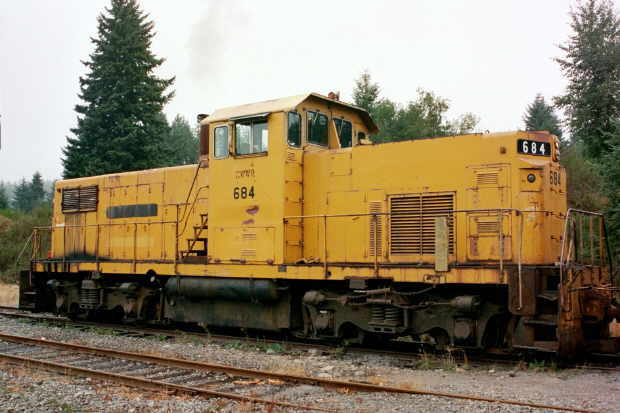 |
||||||||||||||||||
|
(Photo 1-TW-2002-1) Broadside view of the #684. The prime mover is located in the hood on the other side of the cab. |
||||||||||||||||||
|
|
||||||||||||||||||
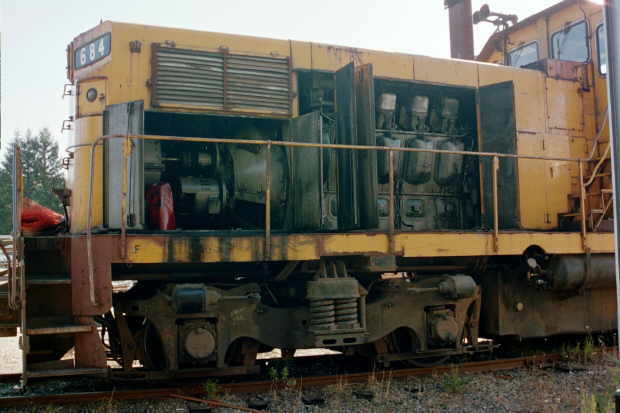 |
||||||||||||||||||
|
(Photo 3-tw-2002-1) View through open hood doors at the prime mover and generator located in the longer of the two hoods. |
||||||||||||||||||
|
|
||||||||||||||||||
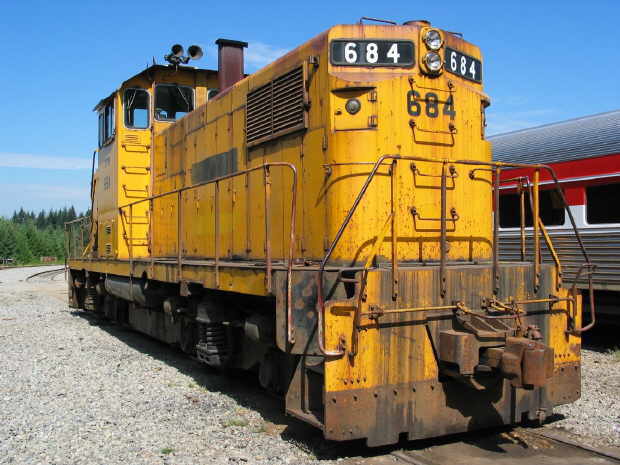 |
||||||||||||||||||
|
(Photo 5_tw_2003-1) Wedge shot of the front and side of the Chehalis Western C415. |
||||||||||||||||||
|
|
||||||||||||||||||